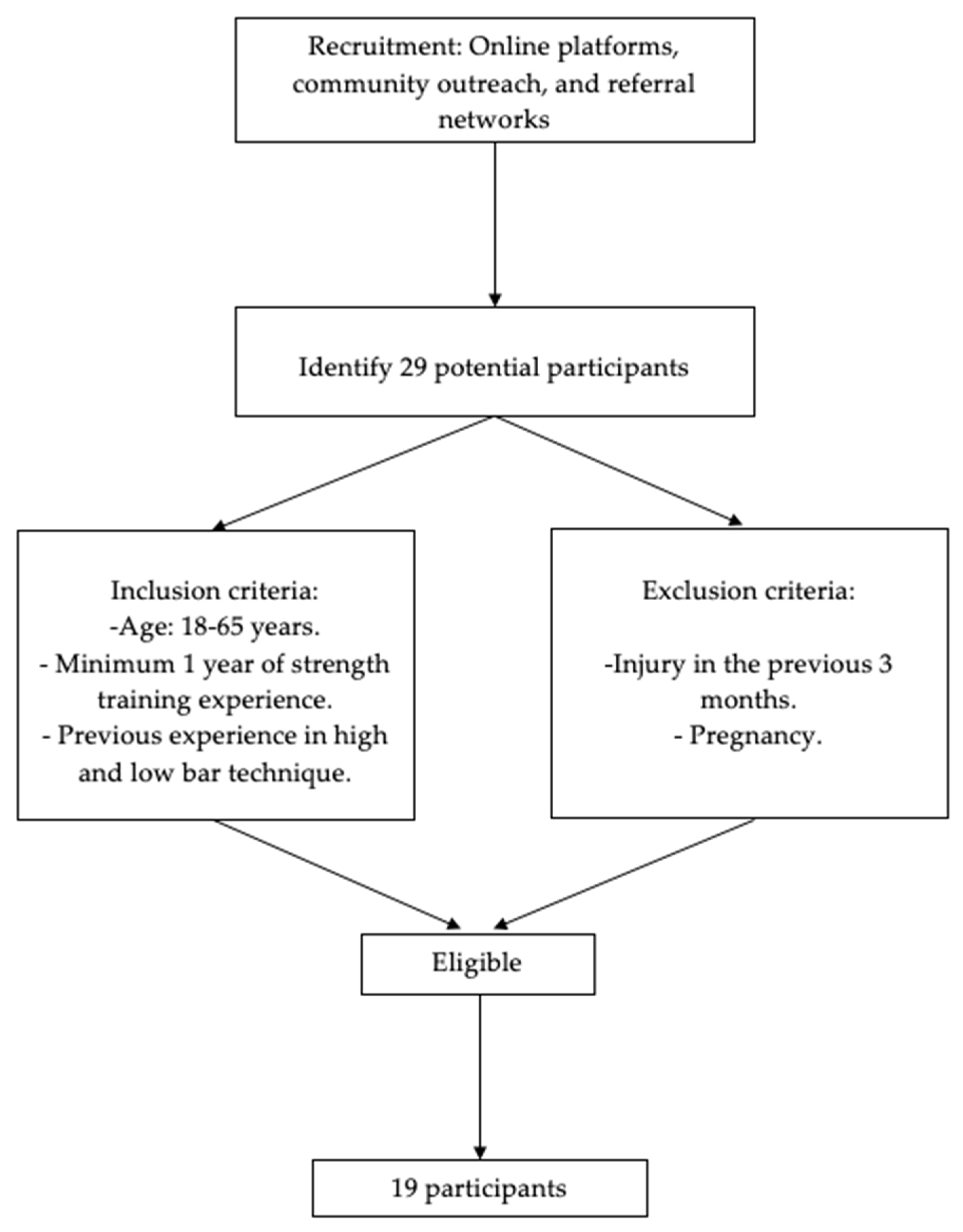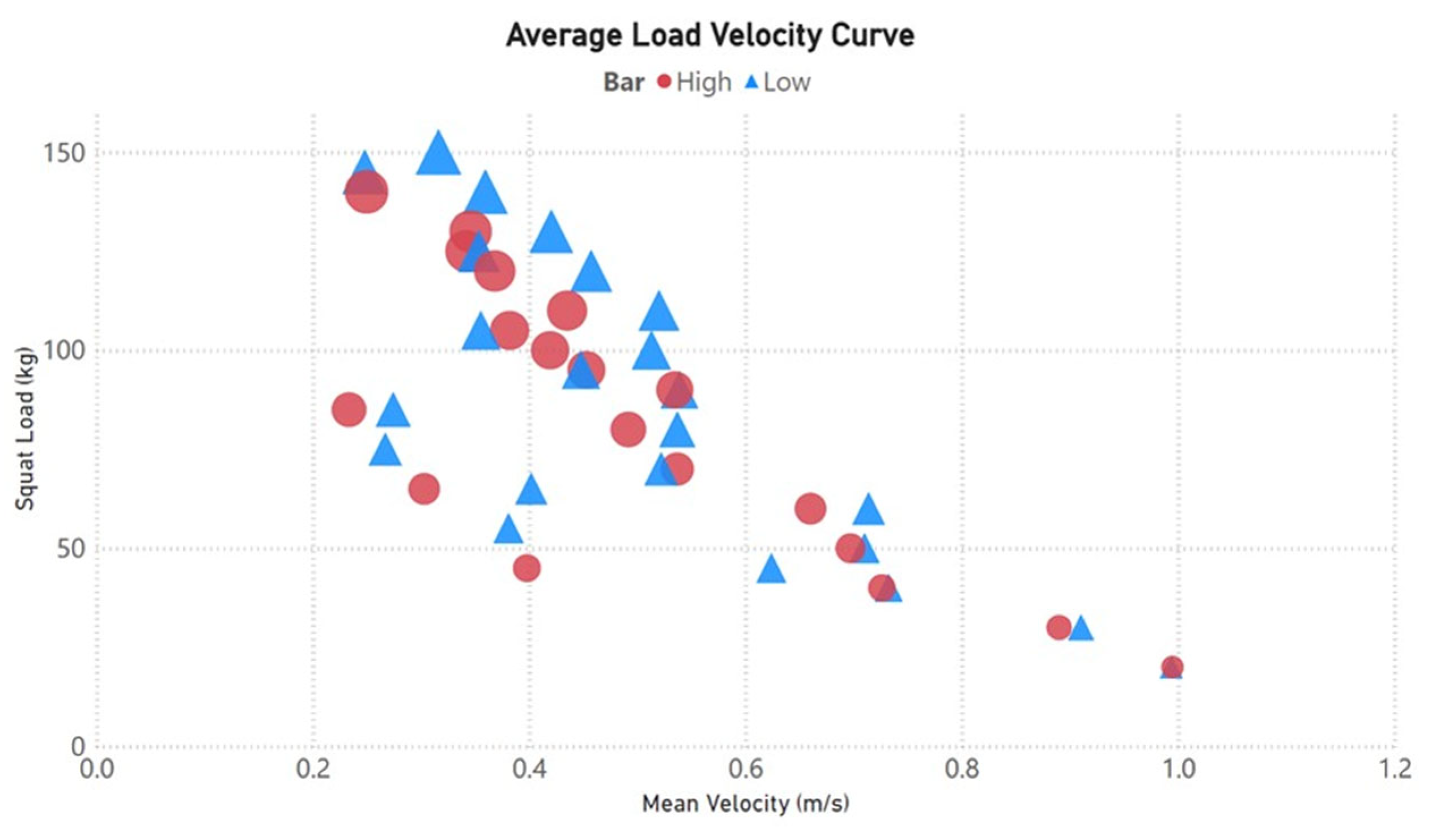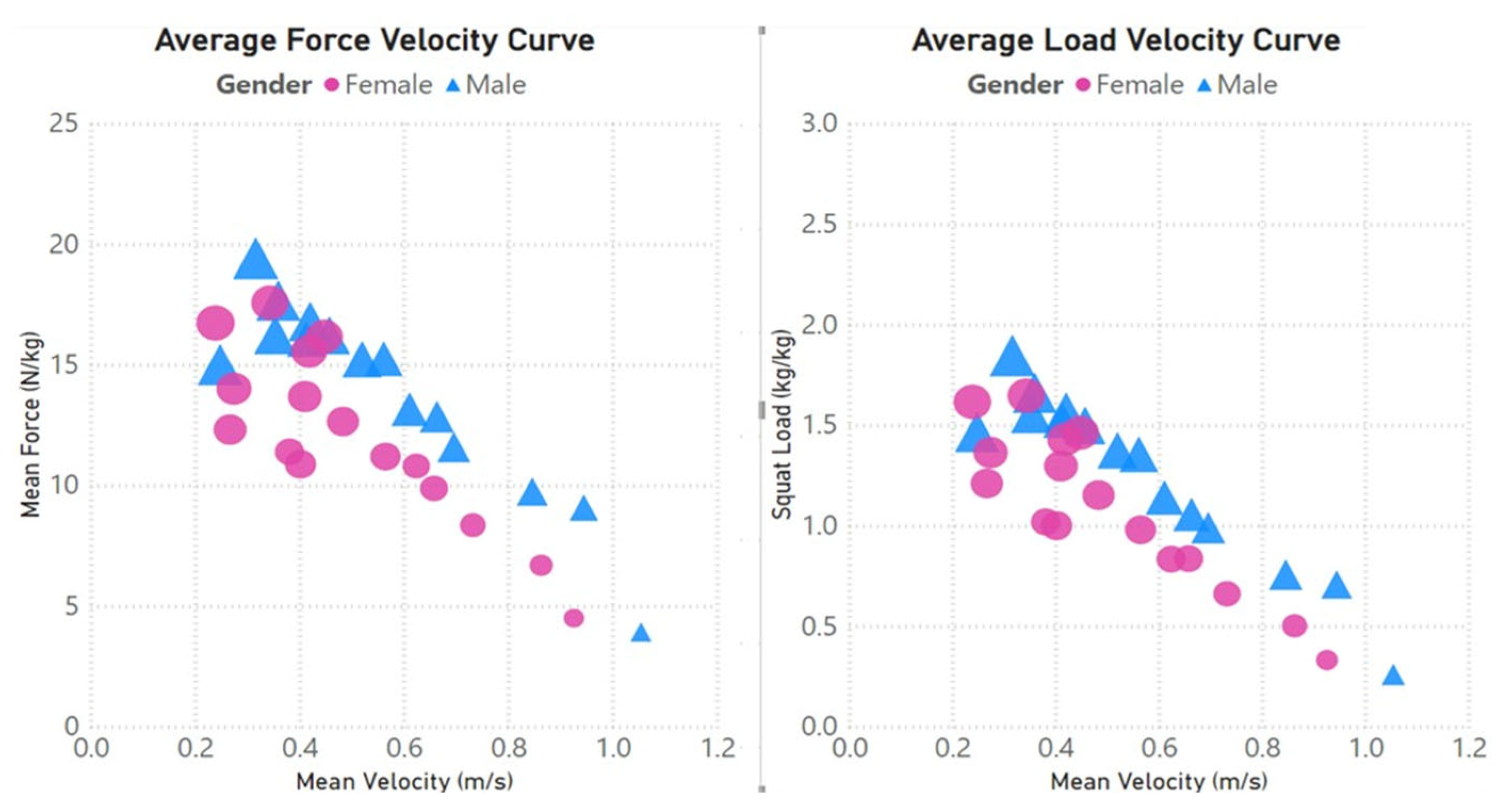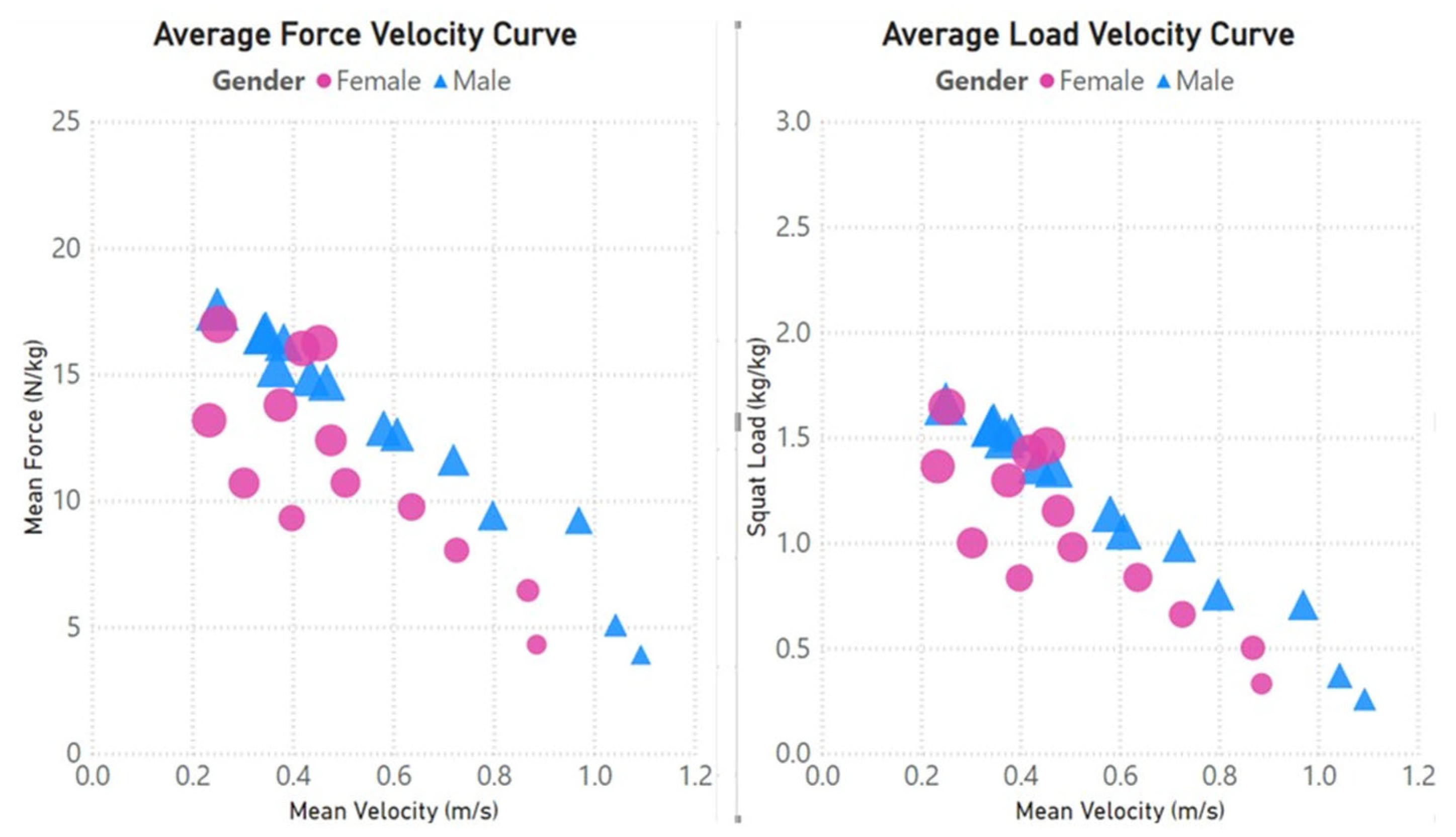Comparative Analysis of Performance in the High-Bar vs. Low-Bar Squat
Abstract
:1. Introduction
2. Materials and Methods
2.1. Study Design
2.2. Participants
2.3. Procedures
2.4. Statistical Analysis
3. Results
4. Discussion
5. Conclusions
Author Contributions
Funding
Institutional Review Board Statement
Informed Consent Statement
Data Availability Statement
Acknowledgments
Conflicts of Interest
References
- Jiménez-Reyes, P.; Samozino, P.; Brughelli, M.; Morin, J.-B. Effectiveness of an individualized training based on force-velocity profiling during jumping. Front. Physiol. 2017, 7, 677. [Google Scholar] [CrossRef] [PubMed]
- Suchomel, T.J.; Nimphius, S.; Bellon, C.R.; Stone, M.H. The importance of muscular strength: Training considerations. Sports Med. 2018, 48, 765–785. [Google Scholar] [CrossRef] [PubMed]
- Fry, A.C. The role of resistance exercise intensity on muscle fibre adaptations. Sports Med. 2004, 34, 663–679. [Google Scholar] [CrossRef] [PubMed]
- Grgic, J.; Lazinica, B.; Schoenfeld, B.J.; Pedisic, Z. Test–retest reliability of the one-repetition maximum (1RM) strength assessment: A systematic review. Sports Med.-Open 2020, 6, 31. [Google Scholar] [CrossRef]
- Sánchez-Medina, L.; González-Badillo, J.; Pérez, C.; Pallarés, J. Velocity-and power-load relationships of the bench pull vs. bench press exercises. Int. J. Sports Med. 2014, 35, 209–216. [Google Scholar] [CrossRef]
- Nieto-Acevedo, R.; Romero-Moraleda, B.; Díaz-Lara, F.J.; Rubia, A.d.l.; González-García, J.; Mon-López, D. A systematic review and meta-analysis of the differences in mean propulsive velocity between men and women in different exercises. Sports 2023, 11, 118. [Google Scholar] [CrossRef]
- Escamilla, R.F. Knee biomechanics of the dynamic squat exercise. Med. Sci. Sports Exerc. 2001, 33, 127–141. [Google Scholar] [CrossRef]
- Escamilla, R.; Lander, J.; Garhammer, J. Biomechanics of powerlifting and weightlifting exercises. In Exercise and Sport Science; Garrett, W.E., Kirkendall, D.T., Eds.; Lippincott Williams and Wilkins: Philadelphia, PA, USA, 2000; pp. 585–615. [Google Scholar]
- Graham, J.F. Back squat. Strength Cond. J. 2001, 23, 28. [Google Scholar] [CrossRef]
- Kompf, J.; Arandjelović, O. The sticking point in the bench press, the squat, and the deadlift: Similarities and differences, and their significance for research and practice. Sports Med. 2017, 47, 631–640. [Google Scholar] [CrossRef]
- Stoppani, J. Jim Stoppani’s Encyclopedia of Muscle & Strength; Human Kinetics: Champaign, IL, USA, 2023. [Google Scholar]
- Liberati, A.; Altman, D.G.; Tetzlaff, J.; Mulrow, C.; Gøtzsche, P.C.; Ioannidis, J.P.; Clarke, M.; Devereaux, P.J.; Kleijnen, J.; Moher, D. The PRISMA statement for reporting systematic reviews and meta-analyses of studies that evaluate health care interventions: Explanation and elaboration. J. Clin. Epidemiol. 2009, 62, e1–e34. [Google Scholar] [CrossRef]
- Glassbrook, D.J.; Helms, E.R.; Brown, S.R.; Storey, A.G. A review of the biomechanical differences between the high-bar and low-bar back-squat. J. Strength Cond. Res. 2017, 31, 2618–2634. [Google Scholar] [CrossRef] [PubMed]
- Clark, D.R.; Lambert, M.I.; Hunter, A.M. Muscle activation in the loaded free barbell squat: A brief review. J. Strength Cond. Res. 2012, 26, 1169–1178. [Google Scholar] [CrossRef] [PubMed]
- Yavuz, H.U.; Erdağ, D.; Amca, A.M.; Aritan, S. Kinematic and EMG activities during front and back squat variations in maximum loads. J. Sports Sci. 2015, 33, 1058–1066. [Google Scholar] [CrossRef]
- Contreras, B.; Vigotsky, A.D.; Schoenfeld, B.J.; Beardsley, C.; Cronin, J. A comparison of gluteus maximus, biceps femoris, and vastus lateralis electromyography amplitude in the parallel, full, and front squat variations in resistance-trained females. J. Appl. Biomech. 2016, 32, 16–22. [Google Scholar] [CrossRef]
- Cotter, J.A.; Chaudhari, A.M.; Jamison, S.T.; Devor, S.T. Differences in Rate of Increased Patellofemoral Joint Reaction Force in the Back Squat Exercise: 2593: Board# 201 June 4 9: 00 AM-10: 30 AM. Med. Sci. Sports Exerc. 2010, 42, 681. [Google Scholar]
- Esformes, J.I.; Keenan, M.; Moody, J.; Bampouras, T.M. Effect of different types of conditioning contraction on upper body postactivation potentiation. J. Strength Cond. Res. 2011, 25, 143–148. [Google Scholar] [CrossRef]
- Sánchez-Medina, L.; Pallarés, J.G.; Pérez, C.E.; Morán-Navarro, R.; González-Badillo, J.J. Estimation of relative load from bar velocity in the full back squat exercise. Sports Med. Int. Open 2017, 1, E80–E88. [Google Scholar] [CrossRef]
- Donnelly, D.V.; Berg, W.P.; Fiske, D.M. The effect of the direction of gaze on the kinematics of the squat exercise. J. Strength Cond. Res. 2006, 20, 145–150. [Google Scholar]
- Hasegawa, I. Using the overhead squat for core development. NSCA Perform. Train. J. 2004, 3, 19–21. [Google Scholar]
- Wretenberg, P.; Feng, Y.; Arborelius, U. High-and low-bar squatting techniques during weight-training. Med. Sci. Sports Exerc. 1996, 28, 218–224. [Google Scholar] [CrossRef]
- Murawa, M.; Fryzowicz, A.; Kabacinski, J.; Jurga, J.; Gorwa, J.; Galli, M.; Zago, M. Muscle activation varies between high-bar and low-bar back squat. PeerJ 2020, 8, e9256. [Google Scholar] [CrossRef] [PubMed]
- Giustino, V.; Vicari, D.S.S.; Patti, A.; Figlioli, F.; Thomas, E.; Schifaudo, N.; Tedesco, M.; Drid, P.; Paoli, A.; Palma, A. Postural control during the back squat at different load intensities in powerlifters and weightlifters. Ann. Med. 2024, 56, 2383965. [Google Scholar] [CrossRef] [PubMed]
- Badillo, J.J.G. La Velocidad de Ejecución Como Referencia Para la Programación, Control y Evaluación del Entrenamiento de Fuerza; Ergotech: Sofia, Bulgaria, 2017. [Google Scholar]
- Aasa, U.; Svartholm, I.; Andersson, F.; Berglund, L. Injuries among weightlifters and powerlifters: A systematic review. Br. J. Sports Med. 2017, 51, 211–219. [Google Scholar] [CrossRef]
- Travis, S.K.; Mujika, I.; Gentles, J.A.; Stone, M.H.; Bazyler, C.D. Tapering and peaking maximal strength for powerlifting performance: A review. Sports 2020, 8, 125. [Google Scholar] [CrossRef]
- Ferland, P.-M.; Comtois, A.S. Classic powerlifting performance: A systematic review. J. Strength Cond. Res. 2019, 33, S194–S201. [Google Scholar] [CrossRef]
- Staheli, N.; Cowley, J.C.; Lawrence, M.M. Comparison of Olympic and Safety Squat Bar Barbells on Force, Velocity, and Rating of Perceived Exertion During Acute High-Intensity Back Squats in Recreationally Trained Men. Int. J. Exerc. Sci. 2024, 17, 1120. [Google Scholar] [CrossRef]
- Haizlip, K.; Harrison, B.; Leinwand, L. Sex-based differences in skeletal muscle kinetics and fiber-type composition. Physiology 2015, 30, 30–39. [Google Scholar] [CrossRef]
- Mehls, K.; Grubbs, B.; Jin, Y.; Coons, J. Electromyography comparison of sex differences during the back squat. J. Strength Cond. Res. 2022, 36, 310–313. [Google Scholar] [CrossRef]
- Lisman, P.; Wilder, J.N.; Berenbach, J.; Foster, J.J.; Hansberger, B.L. Sex differences in lower extremity kinematics during overhead and single leg squat tests. Sports Biomech. 2024, 23, 273–286. [Google Scholar] [CrossRef]
- González-Badillo, J.J.; Sánchez-Medina, L. Movement velocity as a measure of loading intensity in resistance training. Int. J. Sports Med. 2010, 31, 347–352. [Google Scholar] [CrossRef]
- Izquierdo, M.; González-Badillo, J.; Häkkinen, K.; Ibanez, J.; Kraemer, W.; Altadill, A.; Eslava, J.; Gorostiaga, E.M. Effect of loading on unintentional lifting velocity declines during single sets of repetitions to failure during upper and lower extremity muscle actions. Int. J. Sports Med. 2006, 27, 718–724. [Google Scholar] [CrossRef] [PubMed]
- Juárez, D.; González-Ravé, J.M.; Navarro, F. Effects of complex vs non complex training programs on lower body maximum strength and power. Isokinet. Exerc. Sci. 2009, 17, 233–241. [Google Scholar] [CrossRef]
- Pallarés, J.G.; Sánchez-Medina, L.; Pérez, C.E.; De La Cruz-Sánchez, E.; Mora-Rodriguez, R. Imposing a pause between the eccentric and concentric phases increases the reliability of isoinertial strength assessments. J. Sports Sci. 2014, 32, 1165–1175. [Google Scholar] [CrossRef] [PubMed]
- Willardson, J.M.; Burkett, L.N. The effect of different rest intervals between sets on volume components and strength gains. J. Strength Cond. Res. 2008, 22, 146–152. [Google Scholar] [CrossRef]
- Cohen, J. Statistical Power Analysis for the Behavioral Sciences; Lawrence Erlbaum Associates Inc. Publishers: Hillsdale, NJ, USA, 1988. [Google Scholar]
- Mastalerz, A.; Szyszka, P.; Grantham, W.; Sadowski, J. Biomechanical analysis of successful and unsuccessful snatch lifts in elite female weightlifters. J. Hum. Kinet. 2019, 68, 69. [Google Scholar] [CrossRef]
- Suchomel, T.J.; Nimphius, S.; Stone, M.H. The importance of muscular strength in athletic performance. Sports Med. 2016, 46, 1419–1449. [Google Scholar] [CrossRef]
- Logar, J.; Kleva, M.; Marušič, U.; Supej, M.; Gerževič, M. Differences in the knee torque between high-and low-bar back squat techniques: A pilot study. Ann. Kinesiol. 2014, 5, 141–151. [Google Scholar]
- Mausehund, L.; Krosshaug, T. Understanding bench press biomechanics—Training expertise and sex affect lifting technique and net joint moments. J. Strength Cond. Res. 2023, 37, 9–17. [Google Scholar] [CrossRef]
- Alizadeh, S.; Rayner, M.; Mahmoud, M.M.I.; Behm, D.G. Push-Ups vs. Bench Press Differences in Repetitions and Muscle Activation between Sexes. J. Sports Sci. Med. 2020, 19, 289–297. [Google Scholar]
- Jaric, S. Muscle Strength Testing. Sports Med. 2002, 32, 615–631. [Google Scholar] [CrossRef]
- Hunter, S.K.; Angadi, S.S.; Bhargava, A.; Harper, J.; Hirschberg, A.L.; Levine, B.D.; Moreau, K.L.; Nokoff, N.J.; Stachenfeld, N.S.; Bermon, S. The Biological Basis of Sex Differences in Athletic Performance: Consensus Statement for the American College of Sports Medicine. Transl. J. Am. Coll. Sports Med. 2023, 8, 1–33. [Google Scholar] [CrossRef]
- Jidovtseff, B.; Harris, N.K.; Crielaard, J.-M.; Cronin, J.B. Using the load-velocity relationship for 1RM prediction. J. Strength Cond. Res. 2011, 25, 267–270. [Google Scholar] [CrossRef] [PubMed]
- Vigotsky, A.D.; Bryanton, M.A.; Nuckols, G.; Beardsley, C.; Contreras, B.; Evans, J.; Schoenfeld, B.J. Biomechanical, Anthropometric, and Psychological Determinants of Barbell Back Squat Strength. J. Strength Cond. Res. 2019, 33, S26–S35. [Google Scholar] [CrossRef]
- Bryanton, M.A.; Kennedy, M.D.; Carey, J.P.; Chiu, L.Z.F. Effect of Squat Depth and Barbell Load on Relative Muscular Effort in Squatting. J. Strength Cond. Res. 2012, 26, 2820–2828. [Google Scholar] [CrossRef]
- Hopwood, H.J.; Bellinger, P.M.; Compton, H.R.; Bourne, M.N.; Minahan, C. The Relevance of Muscle Fiber Type to Physical Characteristics and Performance in Team-Sport Athletes. Int. J. Sports Physiol. Perform. 2023, 18, 223–230. [Google Scholar] [CrossRef]
- Xu, D.; Zhou, H.; Quan, W.; Ma, X.; Chon, T.-E.; Fernandez, J.; Gusztav, F.; Kovács, A.; Baker, J.S.; Gu, Y. New insights optimize landing strategies to reduce lower limb injury risk. Cyborg Bionic Syst. 2024, 5, 0126. [Google Scholar] [CrossRef]






| Technique | Participants | Load 1RM (kg) | Mean Propulsive Velocity at 1RM (m/s) | Mean Propulsive Force at 1RM (N) |
|---|---|---|---|---|
| High-bar squat | Men (N = 9) | 123.3 ± 14.8 (112.0–134.7) | 0.28 ± 0.07 (0.22–0.33) | 1274.0 ± 143.0 (1165.3–1382.8) |
| Women (N = 10) | 75.5 ± 17.2 (64.7–86.3) | 0.30 ± 0.08 (0.24–0.35) | 788.6 ± 164.4 (685.4–891.8) | |
| Total (N = 19) | 98.2 ± 29.1 *** | 0.29 ± 0.08 | 1018.5 ± 290.9 *** | |
| Low-bar squat | Men (N = 9) | 132.2 ± 16.2 (121.1–143.3) | 0.31 ± 0.05 (0.25–0.37) | 1386.8 ± 184.1 (1268.0–1505.6) |
| Women (N = 10) | 80.5 ± 15.4 (70.0–91.0) | 0.32 ± 0.11 (0.26–0.37) | 842.3 ± 154.2 (729.6–955.0) | |
| Total (N = 19) | 105.0 ± 30.6 *** | 0.31 ± 0.08 | 1100.2 ± 324.0 *** |
Disclaimer/Publisher’s Note: The statements, opinions and data contained in all publications are solely those of the individual author(s) and contributor(s) and not of MDPI and/or the editor(s). MDPI and/or the editor(s) disclaim responsibility for any injury to people or property resulting from any ideas, methods, instructions or products referred to in the content. |
© 2025 by the authors. Licensee MDPI, Basel, Switzerland. This article is an open access article distributed under the terms and conditions of the Creative Commons Attribution (CC BY) license (https://creativecommons.org/licenses/by/4.0/).
Share and Cite
González, M.; Navandar, A.; González-Ravé, J.M.; Ojeda, R.; González-Mohíno, F.; Juárez Santos-García, D. Comparative Analysis of Performance in the High-Bar vs. Low-Bar Squat. Appl. Sci. 2025, 15, 3143. https://doi.org/10.3390/app15063143
González M, Navandar A, González-Ravé JM, Ojeda R, González-Mohíno F, Juárez Santos-García D. Comparative Analysis of Performance in the High-Bar vs. Low-Bar Squat. Applied Sciences. 2025; 15(6):3143. https://doi.org/10.3390/app15063143
Chicago/Turabian StyleGonzález, Manuel, Archit Navandar, José M. González-Ravé, Roberto Ojeda, Fernando González-Mohíno, and Daniel Juárez Santos-García. 2025. "Comparative Analysis of Performance in the High-Bar vs. Low-Bar Squat" Applied Sciences 15, no. 6: 3143. https://doi.org/10.3390/app15063143
APA StyleGonzález, M., Navandar, A., González-Ravé, J. M., Ojeda, R., González-Mohíno, F., & Juárez Santos-García, D. (2025). Comparative Analysis of Performance in the High-Bar vs. Low-Bar Squat. Applied Sciences, 15(6), 3143. https://doi.org/10.3390/app15063143








